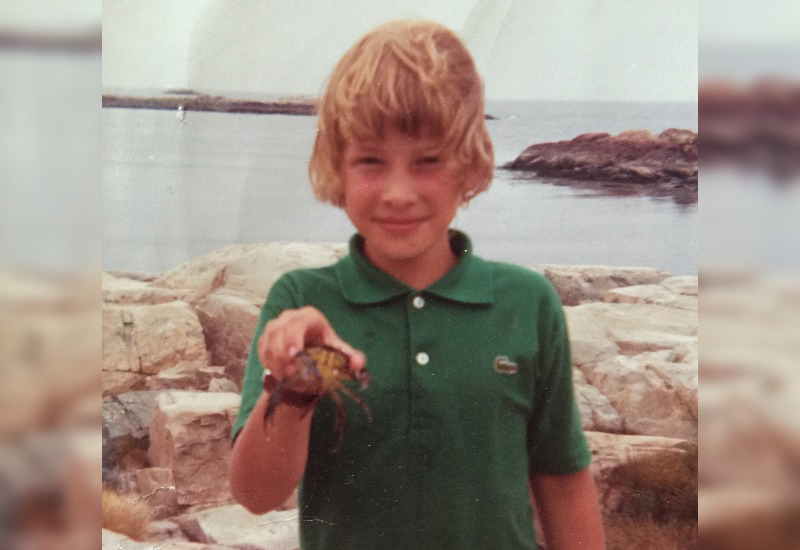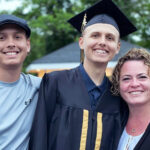Forty years waiting for a cure: ALD gene therapy trial shows early promise

A small piece of notepaper, folded twice, sits tucked in a slot of the secretary desk in the living room. Every so often, I pull it out, read it, then reread.
Addressed to my mom, the paper has a question and two boxes, one “yes” and one “no,” written with the careful precision of a 7-year-old.
I am sad of Ethan. You too?
A check marks the box.
— Yes. Yes, I am sad too.
Learning about adrenoleukodystrophy
My brother Ethan Williams was 9 years old in the fall of 1976, when he began to lose his sight. For my parents, that winter brought an endless round of doctor visits, therapists and lab tests.
After a then-revolutionary CT scan in March 1977, Ethan was diagnosed with adrenoleukodystrophy, a rare neurodegenerative disease few have heard of and most can’t pronounce, so it is simply called “ALD.” This genetic disease destroys the myelin sheath that normally insulates neurons, helping them transmit information to and from the brain.

Silently passed from grandmother to mother to son, ALD is X-linked and rarely affects females, who have two copies of the X chromosome. But for males, who have only one X chromosome, the disease is what my father called “a death sentence.” Rapid and relentless, the symptoms begin with behavioral problems and learning deficits, then progress to blindness, loss of hearing and inability to speak or respond.
In 1977, my father, a doctor, could find just two articles on ALD in the medical literature, and most medical professionals had never heard of it. There was no available treatment.
Three months after diagnosis, Ethan was moved to a nursing home. He had little but his sense of smell remaining, so before entering his room on daily visits, my mother would spray herself with Norell perfume, and my father’s clothing would be freshly infused with cigar smoke. Ethan’s smile would tell them he knew they were there. During his last few months he couldn’t smile anymore.
Ethan died on July 3, 1978.
Treating adrenoleukodystrophy: From oil to gene therapy
Since Ethan’s death, only two treatments have become available for childhood cerebral ALD. The first is a concoction created with two cooking oils, used to reduce the very-long-chain fatty acids (VLCFAs) that accumulate in ALD, made famous in the 1992 film “Lorenzo’s oil”. (The oil is still considered experimental.) The second is allogeneic hematopoietic stem cell transplant, a procedure in which a patient receives blood stem cells from a genetically matched donor. It can slow the progression of ALD but has its own hazards.
“Allogeneic hematopoietic stem cell transplant carries several risks including treatment-related mortality, graft failure, graft-versus-host disease (GVHD) and opportunistic infections due to the immunosuppression used to treat GVHD,” says David A. Williams, MD, president of Dana-Farber/Boston Children’s Cancer and Blood Disorders Center. “Another limiting factor to this procedure, is that it is available only to those patients for whom a highly matched donor is available.”
But on April 20, in Vancouver, Canada, at the annual meeting of the American Academy of Neurology, Cambridge, Massachusetts-based bluebird bio, Inc. announced the preliminary results of its open-label, phase 2/3 gene therapy study. The experimental treatment replaces the lost or deficient ALD protein to help cells break down VLCFAs. The results are not only encouraging but also show the treatment’s promise to avoid complications associated with allogeneic transplant. That is because the experimental therapy is autologous — meaning it uses the patient’s own modified stem cells — negating the need for a donor.
While these study results are early, they are encouraging, and we look forward to further understanding the impact that treatment with Lenti-D gene therapy could have on patients as these data evolve.
The treatment uses Lenti-D, the non-virulent portion of a lentivirus, as the vector (or vehicle) to introduce a functional copy of the ABCD1 gene. Once in the system, the added gene begins encoding for functional ALD protein to replace what is missing.
So far, gene therapy has halted disease progression, as evidenced by both neurologic and radiographic endpoints. All of the study patients are without major functional disabilities, the early results show, and 16 out of 17 have no new clinical neurologic deficits. Major functional disabilities measured included blindness, inability to communicate and wheelchair dependence — all hallmarks of advancing ALD.
On MRI, 14 out of 17 patients showed stabilization of demyelination and atrophy.
“It is exciting to see a potential autologous treatment option for these patients,” says Williams, principal investigator on the study. “While these study results are early, they are encouraging, and we look forward to further understanding the impact that treatment with Lenti-D gene therapy could have on patients as these data evolve.”
A promise
I was only 6 when Ethan was diagnosed with ALD, so it is difficult to discern what I remember from what I’ve been told — or from what I’ve seen in photographs.
I can remember leading my brother through the hallways of our house with his hands firmly planted on my shoulders. I can remember reading to him from his favorite book, Frog and Toad. And I can remember sitting in the sunshine blowing bubbles with an entire pack of grape Bubble Yum in our mouths.
But what I remember best is quietly sitting next to Ethan’s bed, just weeks or possibly days before he was moved to a nursing home. He gently held out his favorite stuffed animal — a seal — and spoke softly, “Take care of him for me.”

Related Posts :
-

Cerebral adrenoleukodystrophy: How the Cooksons dodged a devastating disease
Heather Cookson believes that if she hadn’t insisted her son Ricky get a brain MRI to investigate his frequent ...
-

Gene therapy for adrenoleukodystrophy: Studies find both risks and benefits
Cerebral adrenoleukodystrophy (CALD), portrayed in the film Lorenzo’s Oil, is a devastating disorder caused by a mutation on the ...
-

Shoring up heart muscle’s mini ‘managers’ to treat heart failure
Our heart muscle is studded with tiny dyads, intricately designed structures that manage incoming electrical signals and calcium release to ...
-

Curbing blood cancers by teaching immune cells to kill mutant stem cells
Blood stem cells, which give rise to all of our blood cell types, undergo a quality assurance process after they’...





